Quick Overview: Resolving 404 errors in Shopify is essential for preserving SEO, enhancing user experience, and guaranteeing seamless store operation. The common causes of 404 problems, their effects on your online store, and how to fix them with redirects and best practices for prevention are all covered in this blog. We’ll also go over how to improve interaction with your 404 page and how to prevent mistakes in the future.
Don’t allow broken pages scare away your clients; look for problems in your store. You’re not the only one that sees “Page Not Found” messages or gets a 404 error in Shopify. A lot of store owners have the same problem, but the good news is that it’s easier to remedy than you might think.
This post will show you , set up how to fix 404 errors in Shopify 301 redirects, stop broken links from happening again, and even tell you when you have to hire a Shopify professional or employ Shopify SEO services to keep your business running smoothly.
What Is a 404 Error in Shopify?
A 404 error signifies that the page your consumer is trying to reach doesn’t exist anymore or couldn’t be located. This usually happens when a product or collection was destroyed without a redirect.
- A product or collection was deleted without a redirect
- A URL (handle) was changed
- Internal or external links are outdated or incorrect
- A third-party app changed URL structures
These mistakes not only make the user experience worse, but they also affect your SEO, bounce rate, and conversion rate. That’s why a lot of store owners use a Shopify 404 error fix solution to do the technical work quickly and well.
Common Reasons for 404 Errors in Shopify
Before you can learn how to cure 404 problems in Shopify, you need to know what they are and why they happen.
“Page Not Found” is another name for a 404 error. It is a common HTTP status code that lets users and search engines know that the requested URL is not on the server. Your store is open for business, but the page the visitor wants to see can’t be located. This could be because it was moved, deleted, or never existed in the first place.
404 errors are normally thought of as problems on the client side, but they can also be signs of bigger problems with the structure of your Shopify site, especially if they happen a lot or on pages that get a lot of traffic.
1. Deleted Pages Without Redirects
If you take down a product, blog post, or collection page without making a URL redirect, anyone who tries to go to the old URL will see a 404 error. This happens a lot when things are no longer available or when a site is being cleaned up.
2. Changed URLs (Handles) Without Redirects
You can modify the handle or URL slug of a page in Shopify. When you change a URL, like from /products/t-shirt to /products/cotton-tshirt, and forget to redirect the old one, you are basically blocking access to that page for any links that still point to the old address, whether they are internal or external.
This problem happens a lot when stores are redesigned or when they move from one platform to another, like Shopware to Shopify, and the whole URL structure may change.
3. Mistyped or Broken Links
Not all 404s come from your store. Sometimes the mistake happens because of a typo in an outside link, such one from an email or blog post.
- A typo in an external link (like from an email or blog post)
- A misconfigured ad campaign URL
- User-entered URLs with spelling errors
- Incorrect links in newsletters or social media posts
A 404 might happen even if you make a little mistake, such forgetting a hyphen or using an old path.
Why Should You Fix 404 Error in Shopify?
404 errors might not seem like a big deal, but if you don’t fix them, they could hurt your store’s SEO, performance, and reputation. Fixing them makes sure that customers have a positive experience on your site and keeps it in good standing with search engines like Google. Here are the most important reasons to repair 404 issues on your Shopify site first:
1. Avoid Losing Potential Customers
People that land on a 404 page are considerably more inclined to quit your site right away, especially if they don’t know your brand. If someone clicks on a Google result or an ad for a product and gets stuck, it damages trust and probably costs you a transaction.
For example, what if a customer clicks on a link to a product in your Instagram story and then sees “Page Not Found”? Most people won’t look for it; they’ll just leave.
2. Protect Your SEO Rankings
Search engines like Google see broken links as a sign that a website isn’t being well maintained. A lot of 404 errors can:
- Reduce your site’s crawl efficiency
- Lower your rankings for relevant keywords
- Trigger errors in Google Search Console, affecting overall site health
Fixing or redirecting 404 pages keeps your site optimized and keeps the link equity (PageRank) that it already has.
3. Preserve Valuable Backlinks
If other sites are connecting to your store and the page is no longer there, those links are no longer useful. You can get referral traffic and keep your authority from such backlinks by redirecting broken pages.
Shopify notes: “If the page has backlinks from other websites, you’ll want to preserve their value by setting up a redirect.”
4. Improve Mobile and Ad Campaign Performance
A lot of 404 errors happen because the URLs in ads, emails, or social media posts are old or wrong. If mobile users find a broken page while shopping at your store, they are considerably more likely to leave because they have shorter attention spans. Making sure that links work can help your marketing campaigns work well on all platforms.
5. Provide a Better User Experience
A smooth and dependable browsing experience makes people want to look around your site more and come back later. A redirect or custom 404 page helps users get back on track instead of sending them to a dead end. Think about adding:
- Product recommendations
- A site search box
- Popular categories or recent blog posts
6. Keep Your Site Clean and Professional
When your store gets a lot of 404 errors, it seems old or poorly run. A professional-looking website that is kept up to date builds trust with customers.
How to Find 404 Error on Your Shopify Store
Identifying 404 pages is the first step. Here’s how:
1. Google Search Console
- Go to Coverage > Errors
- Look for “Not Found (404)”
- Export the URLs for redirecting
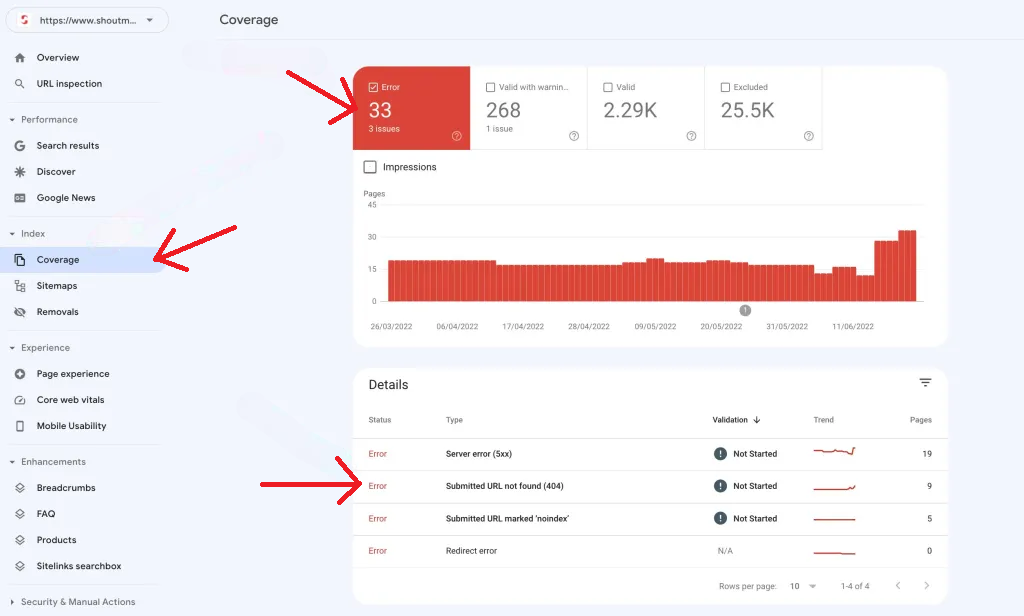
2. Shopify Admin
- Go to Analytics > Reports > Sessions by Landing Page
- Identify broken or low-performing URLs
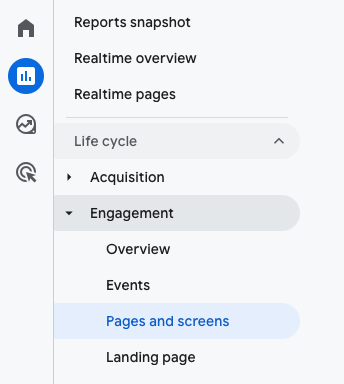
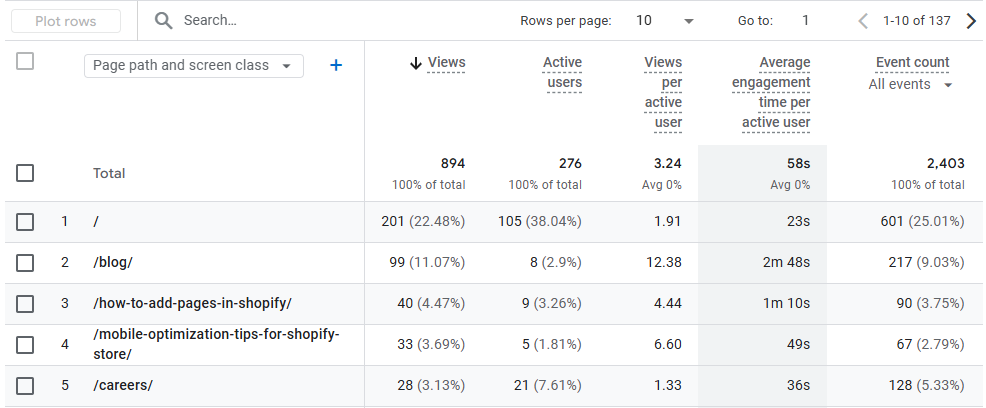
3. Use SEO Tools
Advanced tools like Ahrefs, Screaming Frog, or SEMrush can find hundreds of broken links quickly. This is often included in our Shopify technical support service.
How to Fix Shopify 404 Error (Using 301 Redirects)
The best solution is to redirect broken URLs to live, relevant pages using Shopify’s built-in redirect system.
How to Set Up a Redirect:
- Go to Online Store > Navigation
- Scroll down and click “View URL Redirects”
- Click “Create URL Redirect”
- Enter the broken URL (e.g., /products/red-shirt)
- Enter the working page (e.g., /collections/summer-shirts)
- Click Save


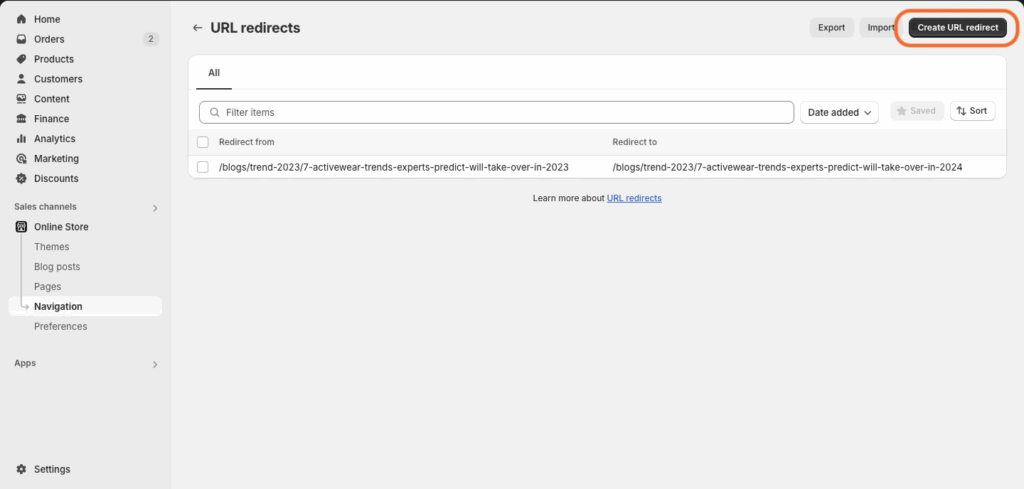
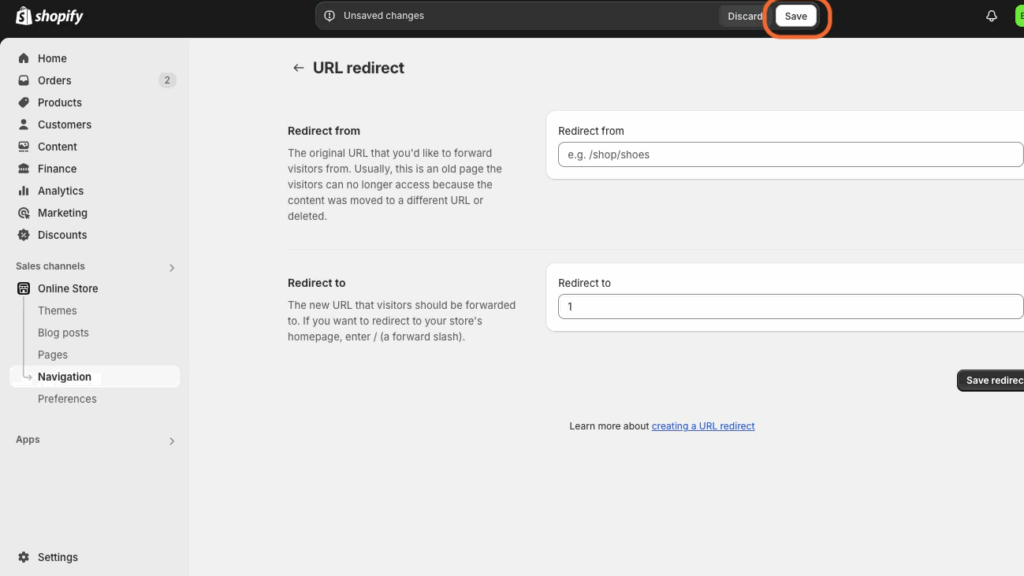
Use relative URLs only (don’t include your domain name).
If you don’t have time or the technical confidence, you can always hire a Shopify expert or request our Shopify redirect service to take care of everything for you.
Are Broken Links and 404 Errors Slowing Down Your Shopify Store?Don’t let 404 errors hurt your sales or user experience. Whether you’re dealing with broken links, missing pages, or redirect issues, we’re here to help. Let our team fix your Shopify 404 errors, optimize your store, and improve your SEO.
Contact Us Today for a Free Shopify Audit
Common Use Cases and Fixes
1. Deleted Product
If a product no longer exists:
- Redirect to a similar product or collection
- Or guide the user to a search results page
Old URL: /products/blue-backpack
New URL: /collections/backpacks
2. Changed Collection Handle
Old URL: /collections/sale-items
New URL: /collections/clearance-deals
Redirects help you retain SEO value and customer traffic even after renaming pages.
Create a Custom 404 Page
Shopify’s default 404 page is plain. Instead, create a custom 404 page that helps the user:
- Add a search bar
- Recommend popular collections
- Offer discounts or a “Continue Shopping” CTA
- Link to customer support or contact page
Need help designing this? Ask about our Shopify store maintenance packages, which include 404 page customization and user experience optimization.
Prevent Future 404 Errors
Here’s how you can avoid 404 errors long-term:
- Don’t delete products or collections without a redirect
- Regularly audit your site with an SEO tool
- Fix broken links in navigation, blog posts, and footers
- Use a Shopify SEO service to stay compliant with best practices
Final Thoughts
Fixing 404 errors in Shopify is one of the most effective things you can do to improve your user experience, SEO, and conversions. If you’re short on time or need expert help, our team offers:
- Shopify 404 error fix service
- Shopify SEO audits and optimization
- Shopify broken link repair
- Ongoing store maintenance and speed improvements
Don’t let 404 errors drain your traffic and sales.
Need Help with Your Shopify Store?
Krishang Technolab offers affordable, expert Shopify technical support to help you run your store efficiently and grow your business. Our services include:
- Custom Shopify Development
- Speed & Performance Optimization
- SEO Setup and Optimization
- Custom 404 Page Design
- Theme Tweaks and UI Enhancements
- Ongoing Shopify Maintenance & Support
Contact Krishang Technolab today to explore our Shopify services from store setup and customization to performance optimization, SEO, and ongoing support. Request your free store audit now!









